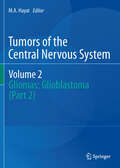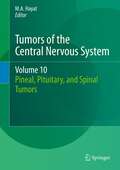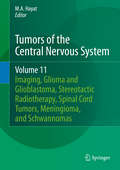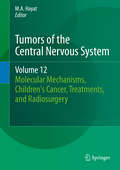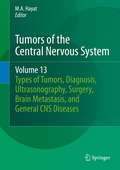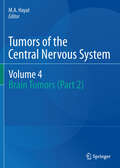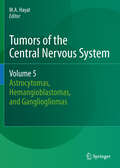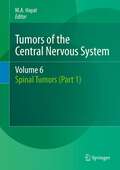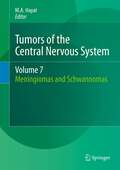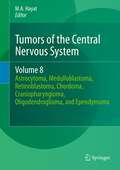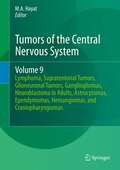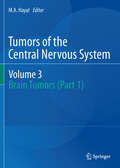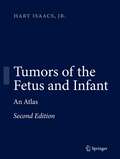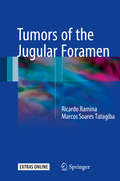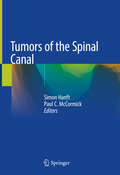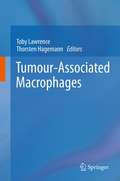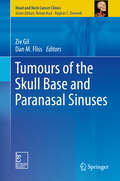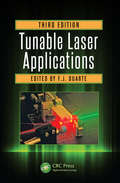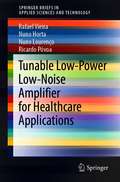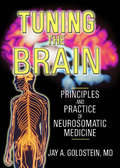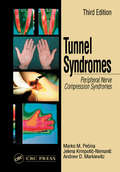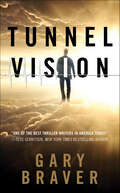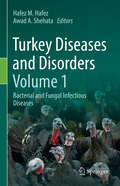- Table View
- List View
Tumors of the Central Nervous System, Volume 2
by M. A. HayatAdvantages and limitations of biomarkers in gliomagenesis are described. Molecular subtypes of gliomas are detailed. The role played by TP53 gene mutation in the deadliest brain tumor, glioblastoma multiforme, is pointed out. The role of mutations of IDH1 and IDH2, and isocitrate dehydrogenases in malignant gliomas are presented. Metabolic differences in different regions of the glioma tumor are clarified. Various types of imaging modalities, including PET and SPECT, to diagnose gliomas in general and glioblastoma in particular in patients are explained in detail. Both low-grade and high-grade gliomas are discussed. Conventional as well as fluorescent-guided resection techniques for high-grade, recurrent malignant gliomas are detailed. Impact of resection extent on outcomes in patients with high-grade gliomas is clarified. The advantage of the use of intraoperative low-field MRI in glioma surgery is explained.
Tumors of the Central Nervous System, Volume 10: Pineal, Pituitary, and Spinal Tumors
by M. A. HayatAdding to a vitally important cycle of publications covering the latest research developments in our understanding of neoplasms affecting the human central nervous system, this edition focuses on numerous aspects of pineal, pituitary, and spinal tumors. As with the previous volumes in the series, this latest work addresses a central imperative in cancer research—the need to standardize classifications, written definitions and investigative guidelines in order to achieve a measure of shared objectivity among academics engaged in one of the most important medical endeavors of our era. It brings together the very latest work by oncologists, neurosurgeons, physicians, research scientists, and pathologists, providing the medical community with a wealth of data and results that, taken together, will advance the cause of cancer research.<P><P> The volume synthesizes work on diagnosis, drug development, and therapeutic approaches that are typically scattered in a variety of journals and books. It features promising recent work in applying molecular genetics to clinical practice and evidence-based therapy, covering molecular profiling of tumors as well as a number of surgical treatments such as resection and radiosurgery. Together with its counterpart publications, it represents a much-needed central resource that will inform and guide future research efforts.
Tumors of the Central Nervous System, Volume 11: Pineal, Pituitary, and Spinal Tumors
by M. A. HayatLike the ten preceding volumes in the series Tumors of the Central Nervous System, this book is distinguished for its comprehensive approach, its distinguished roster of some 93 contributors representing 8 different countries and its embrace of leading-edge technology and methods. Volume 11: Pineal, Pituitary, and Spinal Tumors concentrates on the diagnosis, prognosis and therapy of four types of tumors, namely Glioblastoma, Meningioma, Schwannoma and Spinal Tumors. The book offers an in-depth survey of a range of new technologies and their applications to tumor diagnosis, treatment and therapy assessment. The contributors explain in thorough detail a range of current and newly developed imaging methods, including molecular imaging and PET scan. Also covered is molecular profiling of brain tumors to select therapy in clinical trials of brain tumors. Discussion includes a review of such surgical treatments as resection and the application of non-invasive stereotactic radiosurgery for treating high-risk patients with brain metastasis. Additional discussion is devoted to tumor seeding.
Tumors of the Central Nervous System, Volume 12: Molecular Mechanisms, Children's Cancer, Treatments, and Radiosurgery
by M. A. HayatAs in the case of its eleven predecessors in the series Tumors of the Central Nervous System, this volume is distinguished for its thorough approach, its roster of 92 distinguished contributors representing 11 different countries and its detailed examination of leading-edge technology and methods.<P><P> Volume 12: Molecular Mechanisms, Children’s Cancer, Treatments, and Radiosurgery offers a comprehensive review of the diagnosis, therapy and prognosis of brain and spinal cord tumors. Coverage extends to a large number of tumor types, including neuroblastoma, medulloblastoma, meningioma and chordoma. Molecular profiling of brain tumors to select appropriate therapy in clinical trials of brain tumors is discussed in detail, as is the classification/diagnosis of brain tumors based on function analysis. CDK6 as the molecular regulator of neuronal differentiation in the adult brain, and the role of aquaporins in human brain tumor growth are explained. Discussion also includes tumors affecting children, including neuroblastoma and medulloblastoma. A full chapter is devoted to the role of molecular genetic alterations in medulloblastoma, and another examines survival differences between children and adults with medulloblastoma. The use of various types of imaging methods to diagnose brain tumors is explained. In-depth discussion of treatment options includes stereotactic radiosurgery, endoscopic neurosurgery, electrochemotherapy, transsphenoidal surgery, focal ablation, whole brain radiation therapy and recraniotomy.
Tumors of the Central Nervous System, Volume 13: Types of Tumors, Diagnosis, Ultrasonography, Surgery, Brain Metastasis, and General CNS Diseases
by M. A. HayatVolume 13: Pineal, Pituitary, and Spinal Tumors is organized in six sections, for convenience and quick access to critical information. Section I, Types of Tumors includes a chapter on molecular characterization of Embryonal tumors, a chapter on diagnosis of metastatic oligodendroglioma using fine-needle aspiration cytology, one covering intra-arterial chemotherapy of oligodendroglial tumors and another on the role of cyclooxygenase-2 in the development and growth of Schwannomas, and others, closing with a chapter on trigeminal neuralgia with cerebellopontine angle tumors.<P><P> Section II, Diagnosis, includes two chapters on cell counting in histopathologic slides of tumors. Section III offers three chapters which discuss aspects of intraoperative ultrasonography. Section IV covers brain tumor surgery, and Section V surveys Brain Metastasis. The final section offers a wide-ranging review of General Diseases, with chapters on, among others, Alexander Disease; Lipoma; Transplantation of human umbilical cord blood mononuclear cells in cases of neonatal hypoxic-ischemic brain damage; and a chapter discussing the use of mobile phones and brain cancer risk in children. <P> Like its twelve predecessors in the series, this volume merits distinction for its thorough approach, its roster of 78 distinguished contributors representing 14 different countries and its detailed examination of leading-edge technology and methods.
Tumors of the Central Nervous System, Volume 14
by M. A. HayatThis fourteenth volume of the series provides comprehensive, current information on the diagnosis, therapy and prognosis of brain tumors and spinal tumors. For the readers' convenience, contributions are organized into three categories of Pineal Tumors, Pituitary Tumors, and Spinal Tumors. Readers will find discussion of various aspects of a number of tumor types, including angiocentric glioma, pilomyxoid astrocytoma, pituicytoma, pediatric low-grade gliomas, meningiomas and spinal cord tumors. Expert oncologists, neurosurgeons, physicians, research scientists and pathologists from around the world have contributed to this extensive publication. Their chapters highlight practical experience and provide exceptional insight into the nature of cancer. The authors cover topics ranging from the use of molecular criteria in diagnosis and targeting of medicine, through evidence-based approaches, to in-depth discussion of long-term follow-up after surgery. This handbook, as earlier volumes in the series, will appeal to professionals involved in the treatment of cancer, as well as to researchers. The series crosses subjects of diagnosis, drug development, therapy and its assessment and prognosis of tumors of the central nervous system, cancer recurrence and resistance to chemotherapy.
Tumors of the Central Nervous System, Volume 5: Astrocytomas, Hemangioblastomas, and Gangliogliomas
by M. A. HayatThe most recent developments in diagnostic and therapeutic aspects of Gliomas (glioblastoma) in the brain are presented. The importance of personalized medicine and clinical validation for targeted therapy are discussed. The identification of various types of biomarkers (determined by molecular genetics) is included, along with their advantages and limitations as markers in tumor detection and diagnosis. The identification and validation of brain cancer (glioblastoma) genes are discussed. The role of cancer stem cells in the initiation and persistence of malignant gliomas is explained; response of glioblastoma cancer stem cells to various growth factors, such as epidermal growth factor receptor kinase inhibitor, is explained. The use of surgical resection, chemotherapy (e.g., temozolomide), immunotherapy, and radiation therapy for glioblastoma patients is included. Biological impediments for chemotherapy and radiotherapy for malignant glioblastoma are pointed out. Standard (established) as well as newer imaging modalities (proton magnetic resonance spectroscopy) are discussed. Also included are proton magnetic resonance spectroscopy in intracranial gliomas, and the use of proton magnetic spectroscopic imaging in determining the infiltration zone in gliomas. The role of molecular signaling in the CNS cancer development is explained, including cell death signaling in glioblastoma multiforme.
Tumors of the Central Nervous System, Volume 6: Spinal Tumors (Part #1)
by M. A. HayatThis volume contains information on the diagnosis, therapy, and prognosis of spinal tumors. Various aspects of different major types of spinal tumors (astrocytomas, ependymomas, and oligodendroglioma) are discussed. Insights into the understanding of molecular pathways involved in tumor biology are explained. Classification of intradural spinal tumors, including the percentages of each of the three major types, is detailed. Symptoms, radiological features, and clinicopathological parameters of spinal cord tumors are explained. Diagnosis, outcome, and prognosis of primary spinal cord and oligodendroglioma are discussed. Diagnosis of some other spinal tumors (e.g., pilomyxoid and chordomas) is also explained. The useful role of neuroimaging in diagnosing spinal teratoid/rhabdoid and gangliogliomas is included. A wide variety of treatments of a number of spinal cord tumor types are presented in detail. Therapies discussed include chemotherapy, surgery, radiosurgery, stereotactic radiosurgery, Cyberknife stereotactic radiotherapy, standard radiation alone, and rhenium-186 intracavity radiation. Also are duiscussed embolozation and spondylectomy. The usefulness of transplantation of human embryonic stem cells-derived oligodendrocyte progenitors and motoneuron progenitors in the repair of injured spinal cord is emphasized. Symptoms of the advent of spinal tumors are pointed out. Introduction to new technologies and their applications to spinal cord tumor diagnosis, treatment, and therapy assessment are explained.
Tumors of the Central Nervous System, Volume 7: Meningiomas and Schwannomas
by M. A. HayatVarious aspects, including diagnosis, therapy, and prognosis, of two brain tumors (meningioma and schwannoma) , of brain tumors are discussed in this volume. Insights on the understanding of molecular pathways involved in brain tumor biology are explained. For example, the role of E-cadherin gene instability, carbonic anhydrase 11, urokinase plasminogen activator, and Wnt signaling is discussed in detail. Such information will lead to the development of effective aniicancer drugs. The role of molecular genetics and epigenetic mechanisms in schwannomas is explained. Also, is explained the role of cyclin D1 in vestibular schwannoma. The determination of subtypes of meningiomas using perfusion magnetic resonance imaging is explained. Diagnosis of incidentally discovered meningioma and cystic papillary meningioma is also included. Diagnosis of facial nerve schwannoma, vestibular schwannoma, and intermediate nerve schwannoma is explained. Treatments for atypical meningioma, oncocytic meneingioma, intracranial meningioma, and cavernous are presented. Therapeutic methods such as neurosurgery, Gamma knife radiosurgery, and adjuvant radiation for this cancer are included. Large number of other treatments, including radiosurgery, retrosigmoidal craniotomy, and immunotherapy, for vestibular schwannoma patients are detailed.
Tumors of the Central Nervous System, Volume 8: Astrocytoma, Medulloblastoma, Retinoblastoma, Chordoma, Craniopharyngioma, Oligodendroglioma, and Ependymoma
by M. A. HayatWith tens of thousands of new CNS tumor cases each year in the US alone, this series of publications is a valuable aid to the diagnosis and treatment of these problematic neoplasms. Now, the eighth in the set returns to the topic of brain tumors, dealing with seven distinct types: astrocytoma, medulloblastoma, retinoblastoma, chordoma, craniopharyngioma, oligodendroglioma, and ependymoma. After updating the classification of medulloblastoma the volume provides an overview of ependymoma as well as describing the delineation of prognosis based on the genetic aberrations of the latter patients. The material offers key insights into the molecular pathways involved in tumor biology, such as the role of E-cadherin gene instability, carbonic anhydrase II, urokinase plasminogen activator, and Wnt signaling in meningioma. Contributors explain the genetic and clinical features associated with recurring meningioma, including the role played by erythropoietin receptor, and examine the way in which OTX2 transcription factor functions as an oncogene in medulloblastoma. With much more besides, including discussion of the molecular mechanisms that result in resistance to chemotherapy in medulloblastoma, this volume and its companions have a positive role to play in inspiring a new generation of researchers to design new drugs that are better targeted—and thus more effective.
Tumors of the Central Nervous System, Volume 9: Lymphoma, Supratentorial Tumors, Glioneuronal Tumors, Gangliogliomas, Neuroblastoma in Adults, Astrocytomas, ... Hemangiomas, and Craniopharyngiomas
by M. A. HayatThe ninth volume in this essential series discusses key advances in our understanding of neoplasms in the human central nervous system. This publication deals with various aspects of nine separate types of brain tumors. With 70 contributors from 17 nations, this edition offers an unrivalled thoroughness and breadth of coverage that includes the very latest research results on the following tumor types: astrocytoma, lymphoma, supratentorial and glioneuronal tumors, gangliogliomas, neuroblastoma in adults, hemangioma, and ependymoma.<P><P> The content introduces new technologies and their applications in diagnosis, treatment and therapy of tumors. It explains molecular profiling techniques that enable oncologists to select appropriate therapies for clinical trials, and discusses a number of surgical treatments, including resection and radiosurgery. Volume 9 is interspersed with color illustrations and tables depicting many of the results. This volume joins its fellow publications in a valuable series that fully explores controversies and debates in CNS cancer therapy, and furthers the scientific quest for effective therapies to combat cancer in all its forms.
Tumors of the Central Nervous system, Volume 3: Brain Tumors (Part #1)
by M. A. HayatThe classification of brain tumors is up-dated using magnetic resonance spectroscopy technology. The role of cellular immortality in brain tumors is reviewed. Tumor to tumor metastases are a common occurrence; for example, , brain metastasis from breast cancer, lung cancer, and renal cancer is discussed. Genetic profiling and treatment (including neurosurgery) of such brain cancers are explained. Breast cancer patients treated with certain drugs (e.g., capecitabine and lapatinib can develop CNS tumors. Role of brain tumor suppressor genes (e.g., NRP/B gene) is pointed out. Biomarkers used to diagnose brain malignancies are explained in detail. A number of imaging modalities used for diagnosing and assessing the effectiveness of treatments of brain tumors are presented. The imaging methods discussed include MRI, PET, CT, MRSi, and SPECT. Also, is discussed the impact of PET using radiolabeled amino acids on brain tumors.
Tumors of the Fetus and Infant
by Hart IsaacsOver the past two decades, the remarkable advances in imaging techniques, such as ultrasound and fast or ultra-fast MRI, have led to the diagnosis of an increasing number of tumors at the prenatal stage. This revised, abundantly illustrated second edition of Tumors of the Fetus and Infant: An Atlas presents an up-to-date account of the clinical and pathological features of neoplastic disease and tumor-like conditions in the fetus, neonate, and infant and discusses major tumor studies and cases from throughout the world. The full range of tumors is covered, with each chapter reviewing the incidence, clinical findings, cytogenetics, pathology, radiology, treatment, and prognosis. The goal is to enable pathologists and clinicians to gain a clear understanding of these lesions so that a correct diagnosis can be achieved and appropriate treatment, initiated.
Tumors of the Jugular Foramen
by Ricardo Ramina Marcos Soares TatagibaThis book covers all aspects of the diagnosis and treatment of tumors of the jugular foramen - cranial base lesions that present particular diagnostic and management difficulties and remain challenging to remove despite advances in surgery and interventional neuroradiology. The authors have developed novel concepts and surgical techniques relating to management of the facial nerve, reconstruction of the cranial base, and resection of large tumors with intra- and extracranial extension. These techniques, as well as anatomic studies in cadavers, are presented by means of surgical photographs, illustrations, and videos. Tumors of the Jugular Foramen will be of interest to all specialists involved in the management of these challenging tumors, including neurosurgeons, ENT surgeons, neuroradiologists, neurologists, neurointensivists, radiotherapists, oncologists, and physiotherapists.
Tumors of the Spinal Canal
by Simon Hanft Paul C. McCormickThis book presents a focused, case-oriented approach to a specific disease entity: tumors located within the spinal canal. Each tumor type constitutes its own chapter and additional chapters focus on more novel trends in the field, such as radiosurgery and minimally invasive surgical techniques. In each chapter, the authors provide expert opinions on preoperative goals, intraoperative techniques and decision-making, and postoperative paradigms, including surveillance guidelines and thresholds for initiating adjuvant therapy. The management of intradural tumors has become increasingly interdisciplinary, and one of the major goals of this text is to familiarize the treating neurosurgeon with the latest advances in both operative and non-operative strategies. The text seeks to answer two questions: 1) what are the detailed surgical steps taken by these neurosurgeons to ensure safe maximal resection of these tumors? and 2) in cases of residual and recurrent disease, what are the most effective management options? Consensus regarding definitive management remains difficult to reach given the overall rarity of these tumors. Tumors of the Spinal Canal is ultimately a practical reference drawn from the experiences of its individual authors, a compendium of surgical pearls, pitfalls, and preferences, all steeped in the most recent and relevant literature on the subject.
Tumour-Associated Macrophages
by Thorsten Hagemann Toby LawrenceThe subject of Tumour-Associated Macrophages is of interest in the cancer research community, and this book promises to be among the first to discuss a definitive theory on the role of macrophage in tumor development.
Tumours of the Skull Base and Paranasal Sinuses
by Ziv Gil Dan M. FlissRecent developments in our understanding of the complex anatomy of the cranial base and the biological behaviour of tumours in this area have significantly improved the outcome of patients with skull base tumours. The contributors present a systemic introduction and summary of contemporary knowledge in skull base surgery. The book has three major parts: (i) clinical, pathological and radiological management of patients, (ii) open and endoscopic surgical approaches to the skull base, and (iii) outcome, morbidity and postoperative follow-up of patients. The book is meant for medical students, residents and consultants in various disciplines, including otolaryngology, head and neck surgery, neurosurgery, plastic surgery, maxillofacial surgery and oncology. The emphasis is on the clinical approach to the patient rather than on surgical techniques per se.
Tunable Hydrogels: Smart Materials for Biomedical Applications (Advances in Biochemical Engineering/Biotechnology #178)
by Antonina Lavrentieva Iliyana Pepelanova Dror SeliktarThis book reviews the current knowledge on tunable hydrogels, including the range of different materials and applications, as well as the existing challenges and limitations in the field. It covers various aspects of the material design, particularly highlighting biological responsiveness, degradability and responsiveness to external stimuli. In this book, readers will discover original research data and state-of-the-art reviews in the area of hydrogel technology, with a specific focus on biotechnology and medicine. Written by leading experts, the contributions outline strategies for designing tunable hydrogels and offer a detailed evaluation of the physical and synthetic methods currently employed to achieve specific hydrogel properties and responsiveness. This highly informative book provides important theoretical and practical insights for scholars and researchers working with hydrogels for biomedical and biotechnological applications.
Tunable Laser Applications (Optical Science And Engineering Ser.)
by F. J. DuarteBroadly tunable lasers continue to have a tremendous impact in many and diverse fields of science and technology. From a renaissance in laser spectroscopy to Bose-Einstein condensation, the one nexus is the tunable laser. Tunable Laser Applications describes the physics and architectures of widely applied tunable laser sources. Fully updated and ex
Tunable Low-Power Low-Noise Amplifier for Healthcare Applications (SpringerBriefs in Applied Sciences and Technology)
by Nuno Horta Nuno Lourenço Rafael Vieira Ricardo PóvoaThis book consists of the research, design and implementation, from sizing to layout with parasitic extraction and yield estimation, of a low-power, low-noise amplifier for biomedical and healthcare applications of bio-potential signals, particularly focusing on the electromyography and electrooculography. These signals usually operate in different broadbands, yet follow an impulse-shape transmission, hence being suitable to be applied and detected by the same receiver.
Tuning Autophagy-Inducing Activity and Toxicity for Lanthanide Nanocrystals (Springer Theses)
by Yunjiao ZhangThis thesis presents a simple, yet highly effective surface engineering solution that uses non-covalent binding peptides to control the autophagy-inducing activity of nanomaterials and nanodevices. The author presents RE-1, a short synthetic peptide that sequence-specifically binds to lanthanide (LN) oxide and upconversion nanocrystals with high affinity, which was discovered using an innovative phage display approach. RE-1 effectively inhibits the autophagy-inducing activity and toxicity of these nanocrystals by forming a stable coating layer on the surface of the nanoparticles, and by reducing their sedimentation and cell interaction. RE- 1 and its variants provide a versatile tool for tuning cell interactions in order to achieve the desired level of autophagic response and are useful for the various diagnostic and therapeutic applications of LN-based nanomaterials and nanodevices.
Tuning the Brain: Principles and Practice of Neurosomatic Medicine
by Jay GoldsteinDiscover effective, outcome-oriented ways to help CFS patients who have endured useless or inappropriate treatments! From the author: "For many years I have viewed brain function as a system of electrochemical impulses continually flashing through the brain. These neural networks can often be modulated fairly simply by &’tuning&’ them. The point I have been trying to make for many years is that this process may be pharmacologically regulated extremely rapidly in a manner which does not yet seem to be recognized by the medical profession." In this remarkable volume, Dr. Jay A. Goldstein clearly presents both the theoretical and the practical aspects of his revolutionary approach to treating CFS and other conditions that have often been termed psychosomatic. Dr. Goldstein (author of Chronic Fatigue Syndromes: The Limbic Hypothesis and Betrayal by the Brain: The Neurologic Basis of Chronic Fatigue Syndrome, Fibromyalgia Syndrome, and Related Neural Network Disorders) shows how he achieves results for patients with CFS and a variety of other syndromes in days, rather than months or years. This well-referenced book answers questions, from the most basic to the most complex, including: What is neurosomatic medicine? How did Dr. Goldstein come to pioneer and practice this specialty? What abnormalities in brain function produce neurosomatic disorders? How can an understanding of these abnormalities help you provide effective treatment? Why do these treatments sometimes work so rapidly? What is receptor profiling, and how does it indicate the type of receptor dysregulation in an individual patient? In Part I: Inventing Neurosomatic Medicine, Dr. Goldstein describes the remarkable how and why of his life and his development of this new field of medicine, including his clashes with the medical/psychoanalytic establishment. One of the greatest medical innovators of the modern era, Dr. Goldstein has seen over 20,000 CFS patients and has experienced most of the pitfalls that having such a large number of patients entails. He shares his insight on legal issues, such as how to deal with the law and court systems, how to best provide expert testimony, and how to defend against spurious legal actions. In addition, Dr. Goldstein describes how he learned to work effectively outside of the managed care system. In Part II: Society for Neuroscience Conference Proceedings, the author shares his expertise to bring you experimental results and "pearls of wisdom" relating to neurosomatic medicine from the 28th and 29th Annual Meetings of the Society for Neuroscience-the largest and most important neuroscience conference in the world. Dr. Goldstein sorted through thousands of experiments presented at the conferences to bring you the most relevant findings. Part III: Pathophysiology and Treatment is essential reading for anyone planning to practice neurosomatic medicine. In this section, richly illustrated with over 70 pages of color figures and diagrams that make complicated concepts clear, Dr. Goldstein shares his knowledge about dozens of the agents he uses to help CFS sufferers and others manage their pain, fatigue, and other symptoms. This is information that simply cannot be found anywhere else, and will prove invaluable to all fledgling neurosomatic practitioners. This one-of-a-kind volume is thoughtfully put together-from the extensive list of abbreviations near the beginning to the exhaustive references and an appendix with diagnostic criteria, a treatment algorithm, a medication list of treatment options available now or in the near future, and a checklist of CFS symptoms.
Tunnel Syndromes
by Marko M. Pecina Andrew D. Markiewitz Jelena Krmpotic-NemanicThe need for a comprehensive resource with easy-to-find information has increased with the addition of nine new syndromes. Tunnel Syndromes: Peripheral Nerve Compression Syndromes provides a quick overview of tunnel syndromes including the definition, anatomy, etiology, clinical signs and symptoms, and treatment. It presents a total of 50 tunnel sy
Tunnel Vision
by Gary BraverWhat if you didn't have to die to know that heaven exists?And what if that knowledge could get you killed?Following a biking accident on icy Boston streets, grad student Zack Kashian lapses into a coma. When he wakes up on Easter, months later, muttering the Lord's Prayer in the original Aramaic, the media is set abuzz about the "Miracle Man." Religious fanatics flock to Zack's hospital bedside, though he claims to be an atheist.Zack's revival also catches the attention of Dr. Elizabeth Luria, who heads up a small team of neuroscientists secretly researching near-death experiences (NDE). Their objective: to determine if there is anything to the claims of NDE victims about floating down tunnels into the celestial light and meeting spiritual beings. Is all that evidence of the afterlife? Or is it just neurobiology, as Sarah Wyman, one of Luria's young researchers suspects.For personal reasons, Luria is desperate to prove the afterlife exists. So are her wealthy, evangelist backers, who can't wait to announce the greatest discovery in human history: that God exists. A discovery that would at last reconcile science and religion. A discovery that would end the world's religious strife and unite all humanity.Yet Zack's experiences are anything but heavenly. While he and Sarah struggle to understand his horrific out-of-body experiences, they have no idea that sinister forces have taken an interest in them. Forces to whom near-death experiences are utter blasphemy—deceptions by Satan himself. They enlist a menacing agent who, in the name of God, will stop at nothing to terminate the project and all involved.At the Publisher's request, this title is being sold without Digital Rights Management Software (DRM) applied.
Turkey Diseases and Disorders Volume 1: Bacterial and Fungal Infectious Diseases
by Hafez M. Hafez Awad A. ShehataThis volume 1 of a two-volume work provides an overview of the current state of knowledge on the most common bacterial and fungal diseases in turkeys. Each chapter is dedicated to a specific infectious disease and provides information on pathogenesis, symptoms and therapeutic strategies. The book also includes a general overview on turkey production. The clear and structured layout allows the reader to refer to it quickly. This book is an indispensable guide for veterinarians, researchers and professionals working in turkey production and health.
